Sold Ceramics
Sold Blue and White wares since 1722
Dishes
Page 1
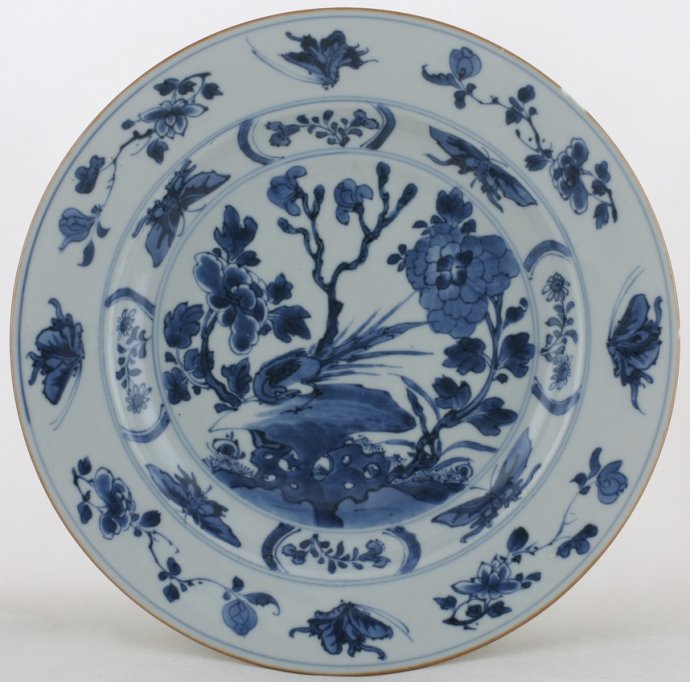
Sold Ceramics - Sold Blue and White wares since 1722 - Dishes - Page 1
Object 2012426
Dish
China
1720-1730
Height 33 mm (1.30 inch), diameter of rim 224 mm (8.82 inch), diameter of footring 110 mm (4.33 inch), weight 313 grams (11.04 ounce (oz.))
Dish on footring, flat underglaze brown-edged rim (jia mangkou). Decorated in underglaze blue with a pheasant on a taihu (garden)rock flanked by various flowering plants. On the sides butterflies alternating with reserves filled with flowering stems. Round the rim butterflies alternating with flower sprays. On the reverse two flower sprays.
The pheasant on a rock is a very popular motif on export porcelain and frequently appears on enamelled and underglaze blue Kangxi wares. (Jörg & Van Campen 1997, p.157) According to Williams, in the Chinese bureaucratic hierarchy officials of the second grade had a gold pheasant embroidered on their court robes, those of the fifth grade a silver pheasant. The bird was represented as standing on a rock, looking towards the sun, the imperial symbol of authority. (Williams 1976, pp.322-323)
The butterfly is the symbol of joy, marital bliss, summer and happiness and a favourite subject in poems and paintings. Sometimes it is called the 'Chinese Cupid' after a story about a young student. When he was chasing a butterfly, he entered a garden where he met the beautiful daughter of a retired magistrate. He was so taken with her charms that he decided to work hard at his studies and to become a success so that he could ask for her hand in marriage. The butterfly dancing among blossom chalices may symbolize the man who refreshes himself with the love of a woman. (Hartog 1990, p.149 & p.151)
For other, sold, objects decorated with a pheasant on a taihu (garden)rock, please see:
Condition: A firing flaw to the base. A frit to the rim and to the reverse rim. A glaze rough spot to the rim.
References:
Price: Sold.

Sold Ceramics - Sold Blue and White wares since 1722 - Dishes - Page 1
Object 2011416
Dish
China
c.1725
Height 35 mm (1.38 inch), diameter of rim 218 mm (9.45 inch), diameter of footring 120 mm (4.84 inch), weight 298 grams (10.51 ounce (oz.))
Dish on footring, flat underglaze brown-edged rim (jia mangkou). Decorated in underglaze blue Chinese kraak style with two branches with fruit, one with pomegranates and one with finger-lemon fruit also called 'Buddha's-hand citron' (Citrus medica). The interior wall is divided into panels filled with swastika, scale-pattern, zig-zag lines and flowers. The reverse is undecorated.
The dish shows a simplified kraak decorative arrangement. Both decorative elements, pomegranates and 'Buddha's-hand citron' (Citrus medica), can also be found on Japanese blue and white Arita dishes from the Edo early period (1615-1703), c.1660-1680. Although the decoration on this dish is reminiscent of kraak, the undecorated reverse, is not.
Object 2010231, Dish, Japan, Arita presumably Sarugawa, 1670-1690 (not included in this offer/sale).
In the cargo of the Ca Mau shipwreck, c.1725 a series of five, identically decorated, dishes were found together with a series of dishes decorated with the Chine de commande 'Scheveningen design'. Both original designs were traditionally made in Arita Japan 1660-1710 for the Dutch. These dishes were so popular that Chinese potters copied them in order to compete with the Japanese. Such copies were already known, but the occurrence in the Ca Mau made it likely that these dishes that these dishes, and therefore most of the porcelain cargo, were destined for Batavia because only the Dutch would appreciate such specific Chine de commande pieces. (Amsterdam 2007, p.17 & p.179)
In 1675 rebel armies swept across Jingdezhen, burning the greater part of kilns in the area to the ground. Five years later the Kangxi Emperor controlled the southern provinces, thus uniting China under his rule. In 1680 the young Emperor expressed his personal interest in the industry of the region by appointing a commission to study the problem of how best to rebuild the ceramic industry in the Jingdezhen area. Trade with the Dutch resumed in 1681. In 1682 the first of a series of able superintendents was appointed to establish and direct a kiln complex organized on an industrial basis which enjoyed Imperial patronage. A few decades after the restoration of the Jingdezhen kilns, some porcelains were still decorated with the kraak motifs which had been so popular during the late Ming Dynasty. Kraak copies produced at Jingdezhen during the last twenty years of the seventeenth century and the first decades of the eighteenth century no longer have grit adhering to the footring or chatter marks on the bases. Rims are not foliate but straight or carefully scalloped with the glaze adhering perfectly without forming the moth-eaten edge so typical for earlier Kraak wares. (Rinaldi 1989, pp.230-232, Pl.293)
The pomegranate, Punica granata, is a Buddhist sign. The fruit is supposed to represent the essence of the favourable influence believed to exist in the pomegranate tree. A twig of the pomegranate is sometimes used instead of willow for sprinkling water. The pomegranate, as in ancient Greece, is, also owing to its numerous seeds, an emblem of posterity. (Williams 1976, pp.332-333)
The 'Fingered citron or Buddha's hand' (Citrus medica) is a small, open citrus with distinctive fruit, native to the foothills of the Himalayas. Around 320 BC, Greeks and Romans used the fruit as a source of fragrance and the leaves as a moth repellent. The fruit has also been used for centuries to perfume clothes and rooms, as ornaments in religious ceremonies and is appreciated for its medicinal qualities. This explains why the Chinese treated it as a precious decorative object in the old days. When the pomegranate ripens it opens up and exposes lots of seeds inside. Chinese people like its pretty appearance, signifying many offspring /children to come. (I am indebted to Mr S. Fan for this information)
For similarly decorated Chinese dishes, please see:
For identically in Chinese kraak style decorated, original Japanese, Edo early period dishes for sale, please see:
-
Japanese Blue and White wares 17th Century - Dishes - Page 1 - Object 2010231.
-
Japanese Blue and White wares 17th Century - Dishes - Page 1 - Object 2010437.
For other identically in Chinese kraak style decorated, original Japanese, Edo early period dishes, please see:
- Japans porselein met blauwe decoraties uit de tweede helft van de zeventiende en de eerste helft van de achttiende eeuw, (D.F. Lunsingh Scheurleer, in, Mededelingenblad Nederlandse Vereniging van Vrienden van de Ceramiek, vols. 64/65, 1971), p.54, cat. 8.
- Pronken met Oosters porselein, exhibition catalogue Gemeente Museum Arnhem, (S. Hartog, Waanders, Zwolle 1990), p.128, cat. 153.
- Japanese Export Porcelain. Catalogue of the Collection of the Ashmolean Museum, Oxford, (O. Impey, Hotei Publishing, Amsterdam, 2002), p.109, cat. 128.
- Fine & Curious: Japanese Export Porcelain in Dutch Collections, (C.J.A. Jörg, Hotei Publishing, Amsterdam 2003), p.28, cat. 8.
Condition: A firing flaw, a frit and a chip to the rim. A hairline and a firing flaw with two connected hairlines to the base.
References:
Lunsingh Scheurleer 1971, cat. 8
Price: Sold.

Sold Ceramics - Sold Blue and White wares since 1722 - Dishes - Page 1
Object 2011888
Dish
China
1730-1740
Height 30 mm (1.18 inch), diameter of rim 264 mm (10.39 inch), diameter of footring 138 mm (5.43 inch), weight 485 grams (17.11 ounce (oz.))
Dish on footring, flat underglaze brown-edged rim (jia mangkou). Decorated in underglaze blue with a parrot perched on a branch of a tree while observing a butterfly in flight. On the rim four medallions filled with a riverscape or flower spray reserved on flowering scrollwork in a white on blue ground. The reverse is undecorated.
The central decoration of the parrot with the large undecorated space suggests a European design as source of inspiration for the decoration on this dish.
For two identically decorated dishes, please see:
Interestingly, an English armorial service dated 1731 made for Charles Peers, Esq. of Chislehampton Lodge, in Oxfordshire, son of Sir Charles who had been Lord Mayor of London in 1715, has a similar motif of a bird on a rock, painted in the same style. For dishes from this service please see:
- Porcelaine de le Compagnie des Indes, (M. Beurdeley, Office du Livre, Fribourg, 1962), p.101, Fig. 69.
- China Trade Porcelain: Patterns of Exchange, (C. le Corbeiller, The Metropolitan Museum of Art, New York 1974', pp.52-53, cat. 23.
- The Choice of the Private Trader. The Private Market in Chinese Export Porcelain illustrated from the Hodroff Collection, (D.S. Howard, Zwemmer, London, 1994), p.67, cat. 45.
- Chinese Export Porcelain in the Reeves Center Collection at Washington and Lee University, (Th.V. Litzenburg, London 2003), p.93, cat. 78.
- Made in China. Porcelain from the Leo and Doris Hodroff Collection at Winterthur (R.W. Fuchs II & D.S. Howard, Winterthur 2005), p.57, cat. 20.
Condition: A fleabite, frit and three chips (two to the rim and one to the inner footring).
References:
Price: Sold.

Sold Ceramics - Sold Blue and White wares since 1722 - Dishes - Page 1
Object 2011518
Dish
China
1740-1760
Height 42 mm (1.65 inch), diameter of rim 248 mm (9.76 inch), diameter of footring 151 mm (5.94 inch), weight 513 grams (18.10 ounce (oz.))
Dish on footring, straight underglaze brown-edged rim (jia mangkou). Decorated in underglaze blue with a flower basket encircled by a foliate and floral scroll border. On the sides reserves filled with flowering lotus plants flanked by reserves filled with a diaper pattern and foliate and floral scrolls. The reverse is undecorated.
The basket filled with all kinds of flowers symbolises riches and abundance and therefore was a highly popular motif, appearing on many Jingdezhen underglaze-blue and polychrome porcelains. In the Netherlands the flower basket design was apparently regarded as very Chinese and exotic, while at the same time being recognisable and fitting in with Western imagery. The motif was often used on Delftware and in particular on Amsterdams Bont, the Dutch name for underglaze or plain white Chinese porcelain, over-decorated in Delft and elsewhere in enamales. (Jörg & Van Campen 1997, p.96), (Jörg 2011/2, p.60)
Condition: A firing flaw to the inner footring and a fleabite to the rim.
References:
Price: Sold.

Sold Ceramics - Sold Blue and White wares since 1722 - Dishes - Page 1
Object 2011497
Dish
China
1730-1750
Height 24 mm (0.94 inch), diameter 231 mm (10.04 inch), diameter of footring 123 mm (4.84 inch), weight 327 grams (11.54 ounce (oz.))
Dish on footring, flat rim. Decorated in underglaze blue with two ladies in a garden landscape observing a man seated at a table in a pavillion playing a zither. On the sides and rim eight panels each filled with a dense floral decoration reserved in white on a blue ground. On the the reverse three flowering peony sprays and on the base a single flowering peony spray.
Romance of the Western Chamber
The love story' Romance of the Western Chamber' (Xixiang ji) ranks among the most famous literary works of China. Its importance for young people can be compared to that of Shakespeare's 'Romeo and Juliet' in the West. 'Romance of the Western Chamber' was written by Wang Shifu (1260-1336). There already existed a short story in the Tang dynasty titled 'Biography of Yingying' (Yingying Zhuan) by Yuan Zhen (779-831), but Wang Shifu adapted it by adding details and giving it a happy rather than a sad ending. It tells the story of a forbidden love affair between the civil servant Zhang Sheng, who is gifted, but of a poor family background, and the pretty Cui Yingying, daughter of the Prime Minister. The two young people have their first encounter in a Buddhist temple, where Yingying and her mother have taken lodgings when accompanying the coffin of the recently deceased father back home. Suddenly, the temple is besieged by a local gang of outlaws, who demand the daughter to be handed over. Yingying's mother promises her daughter's hand in marriage to whoever saves the daughter from falling into the hands of the gang leader. However, when Zhang succeeds in doing so with the help of General Du, his childhood friend, she does not keep her promise. The young couple start a secret affair, supported by Hongniang ('Lady in Red'), Yingying's maid. When Yingying's mother discovers the affair, she consents to the marriage on the condition that Zhang passes the final examination for the highest position in the civil service of the capital, Zhang does so well, that he is granted a top position. (Suebsman 2019, p.43)
On this dish we see Zhang, behind a wall in his room, playing the zither for Yingying who's Hongniang has taken outside. The act is set at night, indicated by the moon just above the clouds. This enchanting episode named 'Listening to the Qin', is traditionally regarded in China as the highlight of the story. (Jörg 2011, p.100, Scene 13)
The peony with leaves decorated on the base of this dish is a revival of the same design seen on the bases of late 17th century dishes made after a Western pewter example. Some of these dishes with Dutch coats of arms, often had the flowering peony on the base. (Jörg & Van Campen 1997, p.255)
Condition: Three chips, one with a connected hairline. and various frits and unglazed spots to the rim.
References:
Jörg & Van Campen 1997, p.158, p.255 & cat. 291
Price: Sold.

Sold Ceramics - Sold Blue and White wares since 1722 - Dishes - Page 1
Object 2011742
Dish
China
1720-1740
Height 25 mm (0.98 inch), diameter 217 mm (8.54 inch), diameter of footring 112 mm (4.41 inch), weight 346 grams (12.21 ounce (oz.))
Dish on footring with a flat underglaze brown-edged rim (jia mangkou)..Decorated in underglaze blue with three fish in a central medallion surrounded by issuing lotus. On the rim eight lotus flower heads enclosed between two rows with half flower heads. The reverse is undecorated.
Ancient Chinese philosophers stress the importance of a rich and affluent nation and people and the balance between abundance and scarcity. The fish and the lotus flowers mean abundance year after year. (Quanxin 2006, pp.104-105)
Condition: A chip and various very tiny frits and fleabites to the edge and the reverse rim.
References:
Price: Sold.
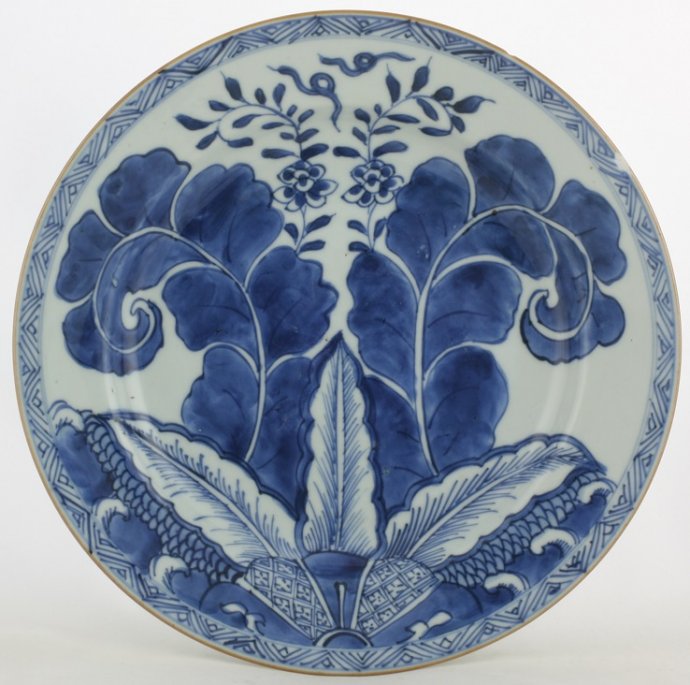
Sold Ceramics - Sold Blue and White wares since 1722 - Dishes - Page 1
Object 2011764
Dish
China
1720-1740
Height 31 mm (1.22 inch), diameter 229 mm (9.01 inch), diameter of footring 121 mm (4.76 inch), weight 387 grams (13.65 ounce (oz.))
Dish on footring with a flat underglaze brown-edged rim (jia mangkou), Decorated in underglaze blue with large tobacco leaves issuing from half a chrysanthemum flower head, its petals filled with a diaper pattern alternating with floral scrolls. On the rim a zig-zag lines pattern border. On the reverse two flower sprays.
The design was also used on armorial porcelain for the Dutch market. On this similarly shaped and sized dish (c.1720-25) there are two coats of arms accollé upside-down on two branches. The male arms on the dexter side with the three spheres or balls are probably those of the Van Blijswijk family from Delft, the Netherlands. The female coat of arms with the reversed chevrons is quite unusual. Unfortunately, no marriage can be traced with the Van Bleijswijk family. (Text and image reproduced from; Chinese Armorial Porcelain for the Dutch Market, Chinese Porcelain with Coats of Arms of Dutch Families, (J. Kroes, Waanders Publishers, Zwolle, 2007), pp.110-111, cat. no. 9a & 9b)
Condition: Two chips to the rim.
References:
Price: Sold.
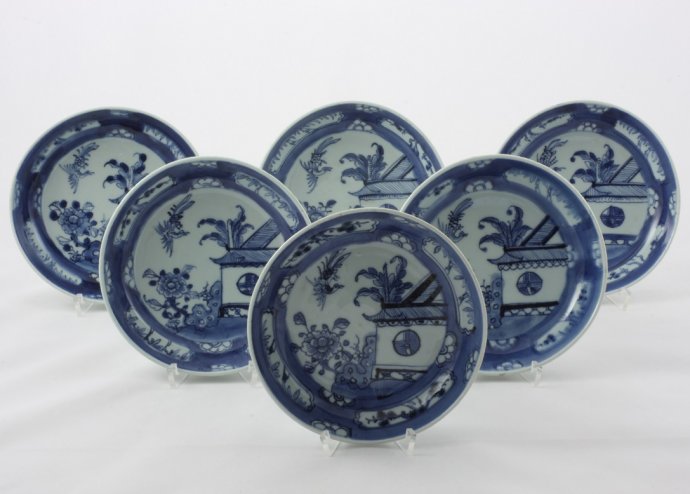
Sold Ceramics - Sold Blue and White wares since 1722 - Dishes - Page 1
Objects 2011873AF
Six dishes
China
c.1770
2011873A Height 35 mm (1.37 inch), diameter of rim 164 mm (6.46 inch), diameter of footring 96 mm (3.78 inch), weight 218 grams (7.69 ounce (oz.)).
2011873B Height 36 mm (1.42 inch), diameter of rim 162 mm (6.38 inch), diameter of footring 95 mm (3.74 inch), weight 233 grams (8.22 ounce (oz.)).
2011873C Height 36 mm (1.42 inch), diameter of rim 164 mm (6.46 inch), diameter of footring 96 mm (3.78 inch), weight 249 grams (8.78 ounce (oz.)).
2011873D Height 35 mm (1.37 inch), diameter of rim 163 mm (6.42 inch), diameter of footring 95 mm (3.74 inch), weight 230 grams (8.11 ounce (oz.)).
2011873E Height 36 mm (1.42 inch), diameter of rim 165 mm (6.50 inch), diameter of footring 95 mm (3.74 inch), weight 242 grams (8.54 ounce (oz.)).
2011873F Height 32 mm (1.26 inch), diameter of rim 163 mm (6.42 inch), diameter of footring 100 mm (3.93 inch), weight 224 grams (7.90 ounce (oz.)).
Six dishes on footrings, straight rims. Each decorated in underglaze blue with a flowering peony growing from a taihu (garden) rock near a pavilion, a perched bird is staring from a circular opening in the pavilion wall towards a phoenix in flight. On the sides and rim four elongated cartouches with pine and bamboo patterns interspersed with half chrysanthemum blossoms on an underglaze blue ground. The reverses are undecorated.
Porcelain wares painted in this way were, alongside idealized landscape scenes, another characteristic in underglaze blue painted product for export to Europe from the 1780s on. The 'friends of winter' design, i.e. a scene with bamboo and a pine tree, is complemented with a simple composition of part of a pavilion with taihu (garden) rocks and a bird in flight, regarded in Europe as a crow or cuckoo. A unique set of these wares with this decoration can be found in the Scharzenberg Hluboká collection, consisting mainly of dishes and bowls of various sizes. Some of them were used not only for everyday gastronomic requirements, but also adorned the walls of rooms. (Suchomel 2015, p.264, cat. 140)
For an identically decorated bowl and dish, please see;
Conditions:
2011873A: A firing flaw to the exterior wall.
2011873B: A firing flaw to the exterior wall.
2011873C: A firing flaw to the base.
2011873D: Firing flaws to the base and exterior wall and a hairline to the rim.
2011873E: A hairline to the rim.
2011873F: A hairline to the rim.
Reference:
Price: Sold.


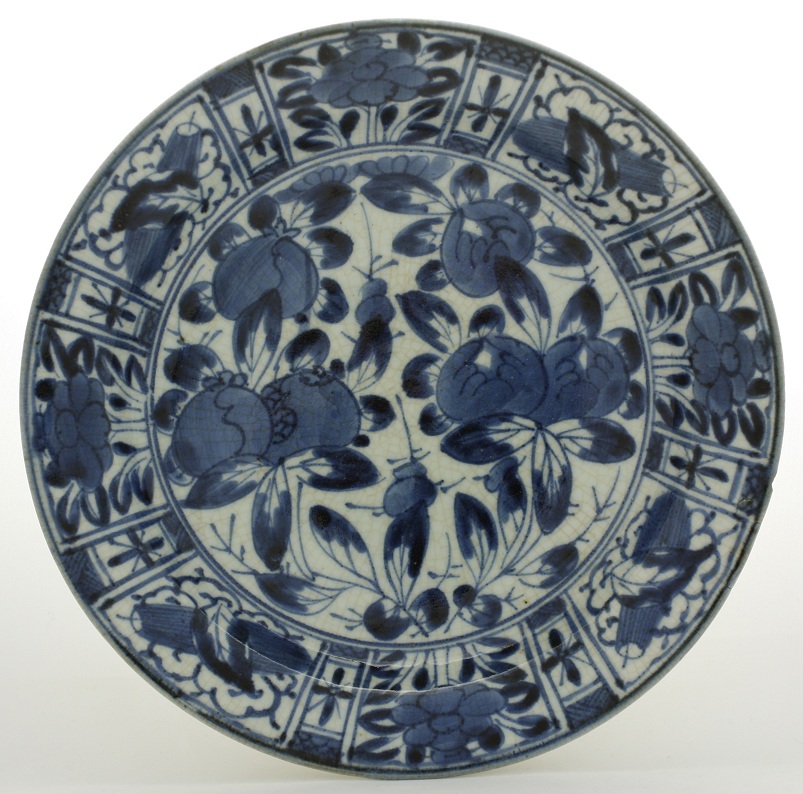


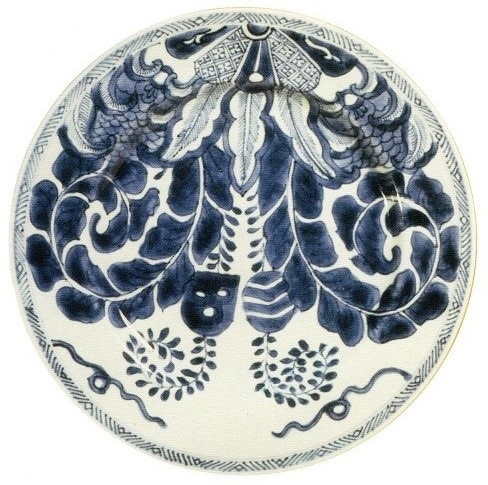
 create websites
create websites